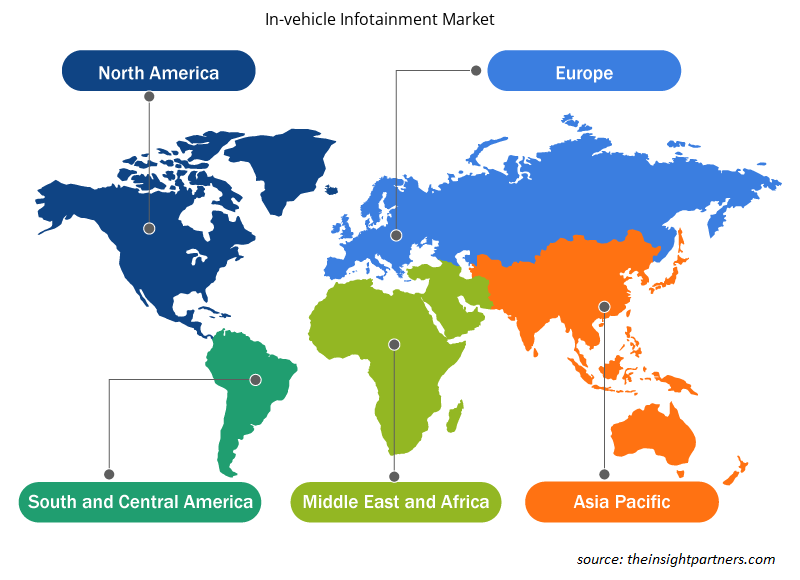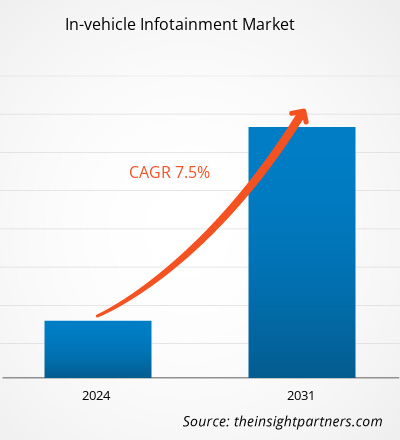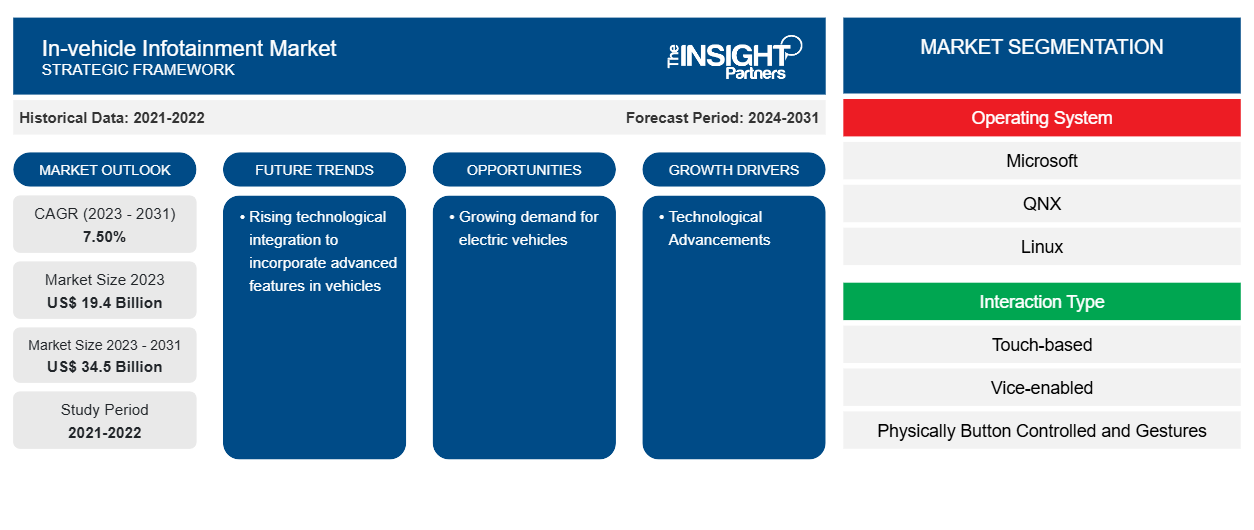Si prevede che la dimensione del mercato dell'infotainment in-vehicle raggiungerà i 34,5 miliardi di dollari entro il 2031, rispetto ai 19,4 miliardi di dollari del 2023. Si prevede che il mercato registrerà un CAGR del 7,50% nel 2023-2031. L'integrazione del sistema di assistenza alla guida avanzata (ADAS) nel sistema di infotainment è una delle tendenze recenti del settore. Le funzionalità ADAS come gli avvisi di abbandono della corsia, l'assistenza al parcheggio e il cruise control adattivo sono alcune delle tendenze recenti del settore che stanno generando opportunità redditizie.
Analisi del mercato dell'infotainment nei veicoli
L'aumento della produzione e delle vendite di veicoli passeggeri è uno dei fattori degni di nota che sta guidando la crescita del mercato dei sistemi di infotainment a bordo dei veicoli. A livello globale, a causa dell'aumento dell'urbanizzazione e dell'aumento del reddito disponibile, le vendite di veicoli passeggeri sono aumentate negli ultimi anni. Secondo i dati pubblicati dall'Organisation Internationale des Constructeurs d'Automobiles nel 2023, la produzione di autovetture passeggeri a livello globale ha raggiunto i 58 milioni di unità nel 2022, tuttavia, nel 2023, la produzione nel 2023 ha raggiunto i 65 milioni di unità. Tale aumento della produzione e delle vendite di veicoli all'anno sta guidando la domanda del mercato dell'infotainment a bordo dei veicoli.
Panoramica del mercato dell'infotainment nei veicoli
La domanda del sistema di infotainment a bordo dei veicoli nell'Asia Pacifica, poiché la domanda di veicoli passeggeri è aumentata negli ultimi anni. La domanda è principalmente guidata dall'aumento del reddito disponibile nell'Asia Pacifica. Secondo i dati forniti dall'Organisation Internationale des Constructeurs d'Automobiles nel 2023, la produzione di autovetture nella regione era di 18 milioni nel 2021, tuttavia, la produzione di autovetture ha raggiunto i 24 milioni nel 2022. Tale aumento del volume delle vendite di veicoli ha aumentato la domanda del mercato dell'infotainment a bordo dei veicoli nell'Asia Pacifica.
Personalizza questo report in base alle tue esigenze
Riceverai la personalizzazione gratuita di qualsiasi report, comprese parti di questo report, o analisi a livello nazionale, pacchetto dati Excel, oltre a usufruire di grandi offerte e sconti per start-up e università
-
Scopri le principali tendenze di mercato in questo rapporto.Questo campione GRATUITO includerà analisi di dati che spaziano dalle tendenze di mercato alle stime e alle previsioni.
Driver e opportunità del mercato dell'infotainment nei veicoli
Progressi tecnologici
Uno dei fattori degni di nota alla base della crescita del mercato è il progresso tecnologico nella tecnologia degli smartphone e del cloud. Con l'aumento della penetrazione degli smartphone, molti produttori di sistemi di infotainment per veicoli hanno iniziato a offrire sistemi con connettività per smartphone . Inoltre, con l'emergere del concetto di tecnologia cloud nelle aziende di software di infotainment per veicoli, hanno iniziato a utilizzare la tecnologia cloud per fornire funzionalità e servizi personalizzati. Pertanto, a causa dell'evoluzione tecnologica nell'infotainment per veicoli, la domanda di infotainment per veicoli è aumentata a livello globale.
Integrazione dell'intelligenza artificiale
Poiché la domanda di veicoli autonomi sta aumentando rapidamente, i sistemi di infotainment a bordo dei veicoli si stanno evolvendo simultaneamente. Inoltre, anche il numero di schermi nelle autovetture sta aumentando, poiché la domanda di intrattenimento e autonomia sta aumentando. Pertanto, molti attori del settore automobilistico si stanno concentrando sull'integrazione dell'intelligenza artificiale nelle loro auto come assistente del conducente.
Analisi della segmentazione del rapporto di mercato dell'infotainment nei veicoli
I segmenti chiave che hanno contribuito alla derivazione dell'analisi del mercato dell'infotainment a bordo dei veicoli sono il sistema operativo, il tipo di interazione e la tecnologia di connettività.
- In base al sistema operativo, il mercato dell'infotainment a bordo dei veicoli è suddiviso in Microsoft, QNX, Linux.QNX, Linux.
- In base al tipo di interazione, il mercato è segmentato in touch-based, vice-enabled, physical button controlled e gestures. Il segmento touch-based ha detenuto la quota maggiore del mercato nel 2023.
- In termini di categoria, il mercato è diviso in Wi-Fi, Bluetooth e NFC. Il segmento Bluetooth ha dominato il mercato nel 2023.
Analisi della quota di mercato dell'infotainment nei veicoli per area geografica
L'ambito geografico del rapporto sul mercato dell'infotainment a bordo dei veicoli è suddiviso principalmente in cinque regioni: Nord America, Asia Pacifico, Europa, Medio Oriente e Africa e Sud America/Sud e Centro America.
Il mercato globale dell'infotainment in-vehicle è dominato dalla regione Asia-Pacifico; tuttavia, anche il Nord America e l'Europa sono tra le regioni più importanti del settore. Nella regione Asia-Pacifico, la Cina è diventata il polo manifatturiero per l'industria automobilistica globale. Secondo i dati disponibili di pubblico dominio, le vendite di automobili in Cina hanno registrato una crescita del 12% nel 2023 rispetto al 2022. Inoltre, secondo le statistiche recenti, la Cina ha registrato esportazioni per oltre 5 milioni nel 2023. Un'industria automobilistica così forte nella regione Asia-Pacifico ha aumentato la domanda di sistemi di infotainment in-vehicle.
Approfondimenti regionali sul mercato dell'infotainment nei veicoli
Le tendenze regionali e i fattori che influenzano il mercato dell'infotainment a bordo dei veicoli durante il periodo di previsione sono stati ampiamente spiegati dagli analisti di Insight Partners. Questa sezione discute anche i segmenti e la geografia del mercato dell'infotainment a bordo dei veicoli in Nord America, Europa, Asia Pacifico, Medio Oriente e Africa e America centrale e meridionale.

- Ottieni i dati specifici regionali per il mercato dell'infotainment nei veicoli
Ambito del rapporto sul mercato dell'infotainment nei veicoli
| Attributo del report | Dettagli |
|---|---|
| Dimensioni del mercato nel 2023 | 19,4 miliardi di dollari USA |
| Dimensioni del mercato entro il 2031 | 34,5 miliardi di dollari USA |
| CAGR globale (2023-2031) | 7,50% |
| Dati storici | 2021-2022 |
| Periodo di previsione | 2024-2031 |
| Segmenti coperti |
Per sistema operativo
|
| Regioni e Paesi coperti |
America del Nord
|
| Leader di mercato e profili aziendali chiave |
|
Densità degli attori del mercato: comprendere il suo impatto sulle dinamiche aziendali
Il mercato dell'infotainment in-vehicle sta crescendo rapidamente, spinto dalla crescente domanda degli utenti finali dovuta a fattori quali l'evoluzione delle preferenze dei consumatori, i progressi tecnologici e una maggiore consapevolezza dei vantaggi del prodotto. Con l'aumento della domanda, le aziende stanno ampliando le loro offerte, innovando per soddisfare le esigenze dei consumatori e capitalizzando sulle tendenze emergenti, il che alimenta ulteriormente la crescita del mercato.
La densità degli operatori di mercato si riferisce alla distribuzione di aziende o società che operano in un particolare mercato o settore. Indica quanti concorrenti (operatori di mercato) sono presenti in un dato spazio di mercato in relazione alle sue dimensioni o al valore di mercato totale.
Le principali aziende che operano nel mercato dell'infotainment a bordo dei veicoli sono:
- Elettronica alpina, Inc.
- Società per azioni Clarion Co., Ltd.
- Continentale AG
- Denso Ten limitata
- Produttore: Garmin
- Harman Internazionale
Disclaimer : le aziende elencate sopra non sono classificate secondo un ordine particolare.

- Ottieni una panoramica dei principali attori del mercato dell'infotainment nei veicoli
Notizie e sviluppi recenti sul mercato dell'infotainment nei veicoli
Il mercato dell'infotainment a bordo dei veicoli viene valutato raccogliendo dati qualitativi e quantitativi dopo la ricerca primaria e secondaria, che include importanti pubblicazioni aziendali, dati associativi e database. Di seguito è riportato un elenco degli sviluppi nel mercato dell'infotainment a bordo dei veicoli e delle strategie:
- Snapp Automotive ha lanciato il sistema di infotainment automobilistico Android. SnappOS è un sistema di infotainment personalizzabile, contestuale e intelligente che consente rapidi cicli di sviluppo e distribuzione in ambienti reali o simulati. (Fonte: Snapp Automotive, comunicato stampa/sito Web aziendale/newsletter, 2022)
- Panasonic Automotive System ha annunciato un aggiornamento per il suo sistema di infotainment di bordo (IVI) SkipGen che fornisce l'accesso a Siri o Alexa. (Fonte: Panasonic Automotive System, comunicato stampa/sito Web aziendale/newsletter, 2023)
Copertura e risultati del rapporto sul mercato dell'infotainment nei veicoli
Il rapporto "Dimensioni e previsioni del mercato dell'infotainment nei veicoli (2021-2031)" fornisce un'analisi dettagliata del mercato che copre le seguenti aree:
- Dimensioni e previsioni del mercato a livello globale, regionale e nazionale per tutti i segmenti di mercato chiave coperti dall'ambito
- Dinamiche di mercato come fattori trainanti, vincoli e opportunità chiave
- Principali tendenze future
- Analisi dettagliata delle cinque forze PEST/Porter e SWOT
- Analisi di mercato globale e regionale che copre le principali tendenze di mercato, i principali attori, le normative e gli sviluppi recenti del mercato
- Analisi del panorama industriale e della concorrenza che copre la concentrazione del mercato, l'analisi della mappa di calore, i principali attori e gli sviluppi recenti
- Profili aziendali dettagliati
- Analisi storica (2 anni), anno base, previsione (7 anni) con CAGR
- Analisi PEST e SWOT
- Valore/volume delle dimensioni del mercato - Globale, Regionale, Nazionale
- Industria e panorama competitivo
- Set di dati Excel
Report recenti
Rapporti correlati
Testimonianze
Motivo dell'acquisto
- Processo decisionale informato
- Comprensione delle dinamiche di mercato
- Analisi competitiva
- Analisi dei clienti
- Previsioni di mercato
- Mitigazione del rischio
- Pianificazione strategica
- Giustificazione degli investimenti
- Identificazione dei mercati emergenti
- Miglioramento delle strategie di marketing
- Aumento dell'efficienza operativa
- Allineamento alle tendenze normative























 Ottieni un campione gratuito per - Mercato dell'infotainment nei veicoli
Ottieni un campione gratuito per - Mercato dell'infotainment nei veicoli